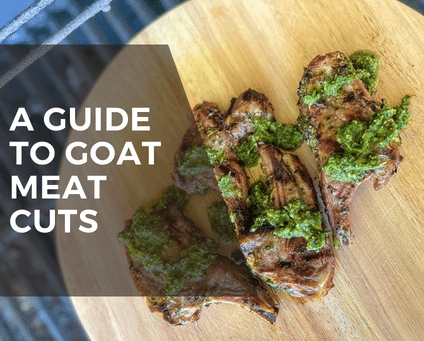Remember how I mentioned that there’s no federal backed marketing order here in the U.S. for meat goats? This is obvious when it comes to even the most basic of information about the different cuts of goat meat. You wouldn’t believe how long I searched for a simple graphic to reference when I was just starting out raising meat goats – and how fruitless that was.
Below you’ll find more information on the most common cuts of goat meat as well as some common ways to cook each of them.

What are Primal Cuts?
It’s important to understand the difference between goat primal cuts and goat meat cuts that are packaged and sold. When looking at the carcass, there are separate large sections that the butcher breaks it down into. These are primal cuts. The primal cuts are then broken down into subprimal cuts.
The suprimal cuts are then broken down into cuts that are packaged and sold, such as goat roasts, chops, ground meat, etc. I’ve organized this blog post by primal cuts from nose to tail with the corresponding “retail” cuts below.
Goat Neck
Typically, the goat neck is broken down into bone-in or boneless goat neck roasts. The neck roast is most often slow cooked, roasted or smoked.
Goat Shoulder
The shoulder most commonly yields bone-in or boneless goat shoulder roasts, shoulder blade chops, and shoulder arm chops. Shoulder roasts can be cooked whole as a main dish or cut into kebabs or stew meat – either way, shoulder roasts are best when slow cooked in the oven/stove or in a slow cooker or pressure cooker.
Goat Rack
The bone-in “rack of goat” is one of the most highly sought after cuts and is often broken down into rib chops for easier preparation and portioning. Chops are incredibly versatile to cook with but are most commonly grilled, broiled, baked or pan fried.
Goat Breast and Foreshank
Together, the goat breast and foreshank tend to yield boneless breast and rolled breast cuts. Also sometimes called the brisket, the breast is best when slow roasted to render the fat and for maximum tenderness.
Goat Loin
Being along the back and behind the rack, cuts taken from the goat loin tend to be on the leaner side. These include bone-in or boneless goat loin roasts, goat tenderloin, goat loin chops and saddle chops (when two goat chops are cut together). Goat chops in particular are one of the most popular cuts of goat meat and are most often grilled or pan-fried.
Goat Leg
The largest of the primal cuts, the goat leg can be broken down into many different cuts including leg of goat, sold bone-in, butterflied, or with shank, goat leg steaks, sirloin goat steaks, sirloin goat chops, boneless goat sirloin roast, inside or top round, and outside or bottom round. These roasts are typically slow cooked or roasted for the best flavor and tenderness.
Goat Offal
Aside from the primal cuts that make up the muscle, the remainder of the goat carcass can be literally and figuratively broken down into stew meat, ground goat meat, and offal. Offal is another word for the organ meat, i.e the liver, kidneys, heart, and tongue, as well as the bones. Goat offal can be delicious when prepared properly and is also incredibly nutritious, providing large amounts of essential vitamins and minerals in each serving.

Extremely timely information! We have our first visit to the meat processor scheduled next month, and gathering this type of detail has been a challenge.
Amanya Mishambi from Uganda. This is a very informative article. Double thumbs up.
This truly is an excellent article. Very informative, and thank you for taking the time to inform those of us (as with many others) whom are unaware of goat as an edible meat in the United States Of America.
I am in the process of making my first spicy Mexican birria soup/stew, and I am using goat which is the traditional Jalisco traditional method for this dish. I live in Detroit, Michigan, and all goat if bought in a store is only sold at a specialty meat market. My goat, specifically, was purchased at the African Imperial Market.
I liked your comment regarding there not being a goat meat marketing program in the United States, as there is with beef, pork, chicken, etc.. This is the reason why many persons here do not even think goat can be eaten, or otherwise is perceived as ‘taboo’ or seen as a something only persons from other countries or traditions eat.
This meal will be my first time ever eating goat, and I am not even telling my family that is the meat they are eating until afterwards!! I did the same thing when I made bison burgers instead of standard beef burgers, which they absolutely loved!! It is a funny thing how so many persons have such a restrained feeling towards trying/eating something ‘new’ or something they are not accustomed to or is seen as ‘nontraditional’.
Again, thank you so much for your knowledge and overall your article!
I will report back on how the dish went!
-Marc; Redford, Michigan